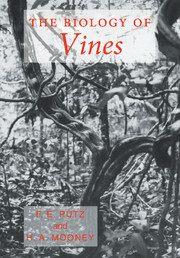Book contents
- Frontmatter
- Contents
- List of contributors
- Foreword
- Preface
- Acknowledgements
- I INTRODUCTION
- II CLIMBING MECHANICS AND STEM FORM
- III VINE PHYSIOLOGY AND DEVELOPMENT
- IV COMMUNITY ECOLOGY OF VINES
- V ECONOMIC IMPORTANCE OF VINES
- 16 The ethnobotany and economic botany of tropical vines
- 17 Biology, utilization, and silvicultural management of rattan palms
- 18 Silvicultural effects of lianas
- Taxonomic index
- General index
16 - The ethnobotany and economic botany of tropical vines
Published online by Cambridge University Press: 05 November 2011
- Frontmatter
- Contents
- List of contributors
- Foreword
- Preface
- Acknowledgements
- I INTRODUCTION
- II CLIMBING MECHANICS AND STEM FORM
- III VINE PHYSIOLOGY AND DEVELOPMENT
- IV COMMUNITY ECOLOGY OF VINES
- V ECONOMIC IMPORTANCE OF VINES
- 16 The ethnobotany and economic botany of tropical vines
- 17 Biology, utilization, and silvicultural management of rattan palms
- 18 Silvicultural effects of lianas
- Taxonomic index
- General index
Summary
Introduction
What makes a plant useful? Two distinct components are needed: firstly, the evolutionary processes that shape the plant's biochemistry, physiology and physiognomy, and secondly, the human quality of taking a curious interest in these plants and so discovering the edible and the poisonous, the remedial and the toxic. Both requisites are most fully satisfied in the tropics, and in particular the tropical rainforest, and this is one reason why tropical forests are such an invaluable resource. Here the intensity of biotic interactions has resulted in a myriad of secondary plant products (see Levin, 1976), and this process may have been especially prevalent in the woody climbers, a life form essentially restricted to the tropical forest. And it is here, even today, that the greatest diversity of indigenous cultures persists, maintaining a treasuretrove of ethnobotanical information. Still, indigenous peoples have been worse than decimated (the Indian population of Brazil is only 0.1% of its 1492 level and current tribal extinction rates are more than one per year (Posey, 1983)), representing an irreversible loss in cultural diversity.
This indigenous knowledge is also the foundation for the use of plants as medicine and food by the wider rural population of the South. The World Health Organization estimates that 80% of the population of developing countries relies on traditional medicine for primary health care, and that 85% of traditional medicine involves the use of plant extracts.
- Type
- Chapter
- Information
- The Biology of Vines , pp. 427 - 476Publisher: Cambridge University PressPrint publication year: 1992
- 1
- Cited by

